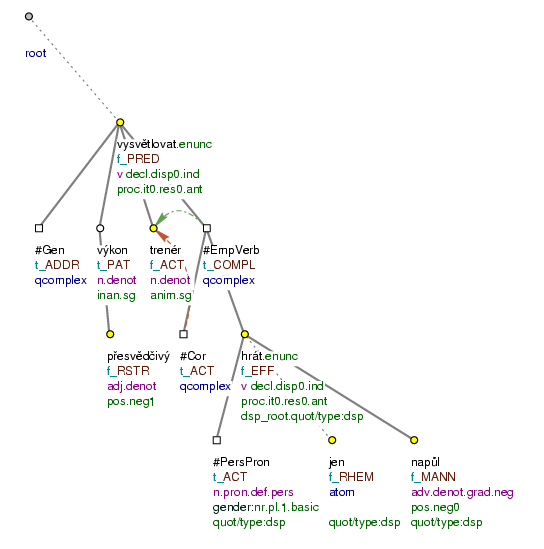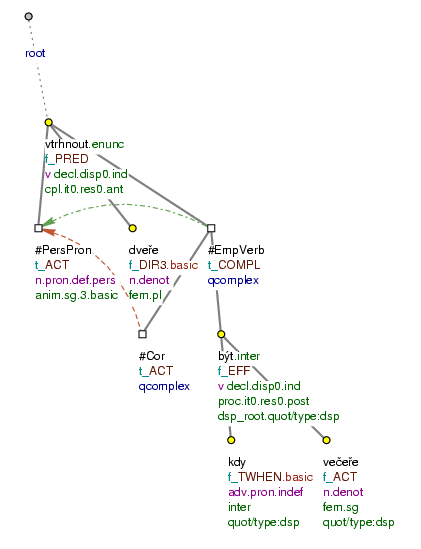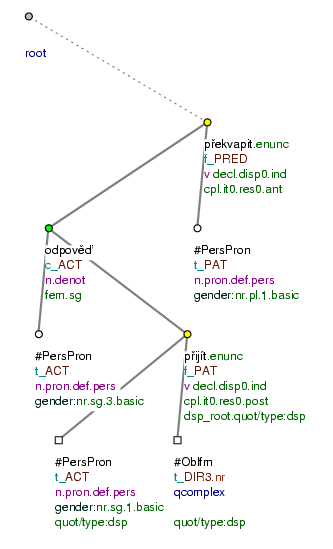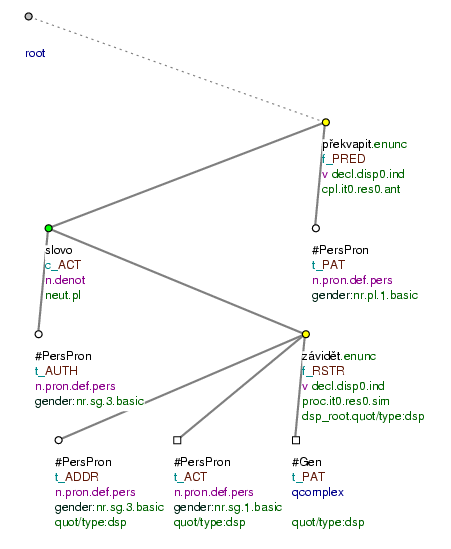Direct speech introduced by a reporting clause is represented primarily as an argument of a word in the reporting clause.
The option to express one of the arguments by means of direct speech is recorded in the valency frame of the given word by the symbol .s (on this, see Section 5.1, "The notation of valency frames").
Direct speech may express the argument of a verb (Section 3.1.1, "Direct speech as the argument of a verb"), a noun (Section 3.1.2, "Direct speech as modification of a noun") or an adjective. If direct speech is introduced by an adjective, it is similarly represented according to the rules relating to direct speech introduced by a verb.
If the direct speech expresses the argument of a verb (or adjective) in the reporting clause and unless the given valency position is already occupied by another modification, the effective root node of the direct speech has the functor of one of the arguments and is dependent on the node for the verb.
Direct speech is represented as an argument in the case of many verbs of speaking and verbs meaning the reproduction of spoken utterances, written text and unexpressed ideas.
Examples:
Ozvalo se: " Nechoď.ACT tam!" (=The command was heard: "Don't go there!") Fig. 8.39
Řekli mu: " Nechoď.EFF tam." (=They told him: "Don't go there".)
Vyzvali nás: " Jděte.PAT všichni ven." (=They called on us: "Come out, all of you.")
Napsali o nás: " Jsou.EFF to dobří lidé." (=They wrote about us: "They are good people.")
Pomyslela si: " Jsem.EFF dobrá." (=She thought: "I'm good.")
Direct speech as a non-verbal part of a verbonominal predicate. Direct speech replacing the non-verbal part of a verbonominal predicate is also represented as an argument. The effective root node of the direct speech has the functor PAT. For example:
Jeho odpověď byla: " Přijdu.PAT " (=His reply was: "I'll come.") Fig. 8.40
Jeho slova byla: " Závidím.PAT mu." (=His words were: "I envy him.")
Jeho hodnocení je: " Hráli.PAT výborně." (=His evaluation is: "They played excellently.")
Apposition of direct speech and its paraphrase. A construction may also contain first of all the content of direct speech, freely paraphrased, followed by a literal quotation of the statement. In such a case the direct speech and its paraphrase are represented as being in apposition (this type is distinguished from the type with a filled-in valency position; see Section 3.1.1.1, "Specific constructions in which direct speech is represented as an argument of the verb"). For example:
Řekl, že nepřijde.EFF [is_member=1] : "Určitě se nedostavím.EFF [is_member=1] ." (=He said that he would not come: "I definitely won't turn up.") Fig. 8.41
A punctuation mark instead of a reporting verb. Direct speech is also represented as an argument when it is incorporated in a clause which contains no verb, but in which the node for a punctuation mark (a colon) standing for the absent verb is represented as the effective root node in the function of a predicate (see Section 4.1, "Verbal clauses"). In these constructions, the effective root node of the direct speech has the functor PAT. For example:
Trenér Sparty: " Nehráli jsme.PAT špatně." [ #Colon.PRED] (=The Sparta coach: "We didn't play badly.") Fig. 8.42
Martina Hingisová: "Hráčky mě akceptovaly.PAT " [#Colon. PRED] (=Martina Hingisová: "The players accepted me.")
Figure 8.39. Direct speech as argument of the reporting verb
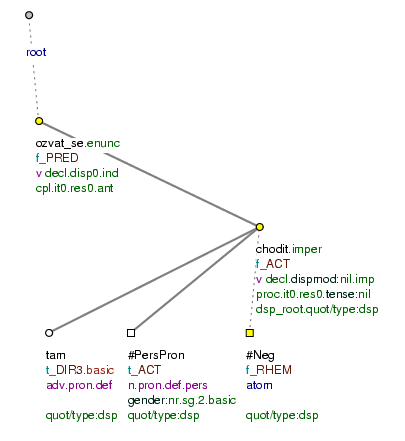
Ozvalo se: "Nechoď tam!" (=lit. Was_heard REFL: "Don't_go there!")
Figure 8.40. Direct speech as argument of the reporting verb
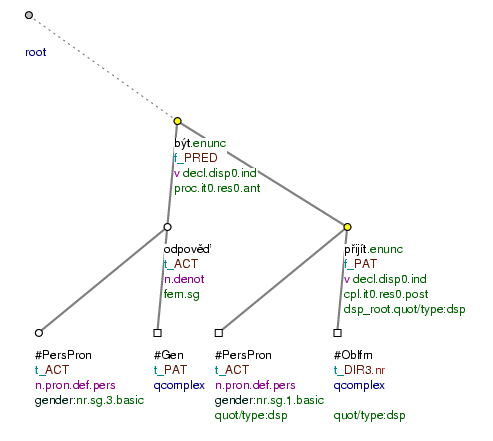
Jeho odpověď byla: "Přijdu." (=lit. His answer was: "I'll_come.")
Figure 8.41. Direct speech as argument of the reporting verb
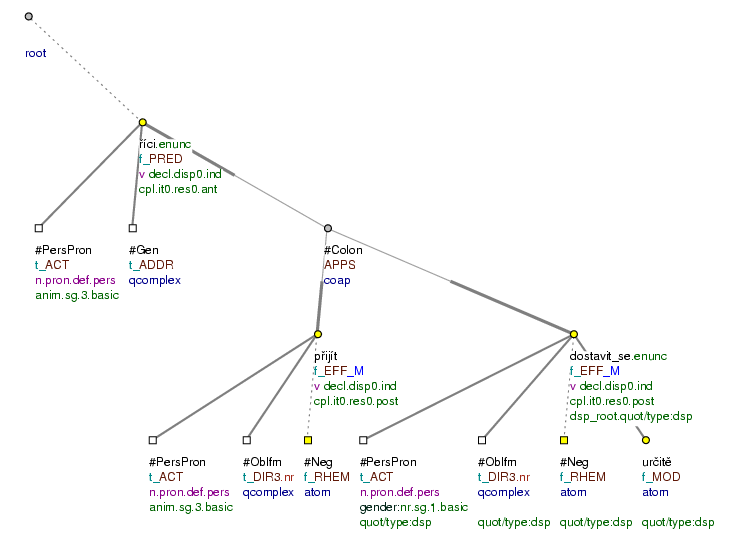
Řekl, že nepřijde: "Určitě se nedostavím." (=lit. (He) said that (he) would_not_come: "(I) definitely REFL won't_turn_up.")
Figure 8.42. Direct speech as argument of the reporting verb
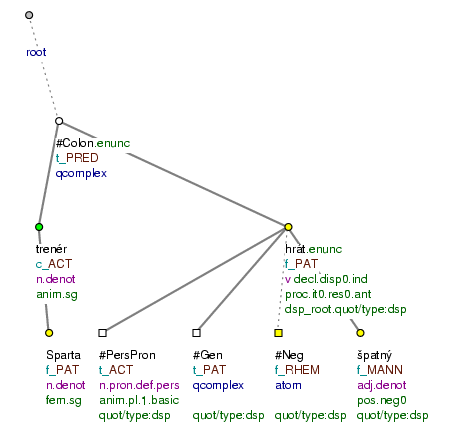
Trenér Sparty: "Nehráli jsme špatně." (=lit. (The) coach (of) Sparta: "(We) didn't_play AUX badly.")
If direct speech does not express a modification of the reporting verb (or adjective) and it cannot be represented as a modification of a noun (see Section 3.1.2, "Direct speech as modification of a noun"), it is represented, if such an interpretation is possible, in one of the following ways:
-
a node standing for the infinitive of the verb of saying is added to the tectogrammatical tree.
If it is possible to modify the verb in the reporting clause by the infinitive of a verb of saying (for example říkat (=to say)) as its argument , a new node is added to the tectogrammatical tree with the t-lemma substitute
#EmpVerband with the functor of the appropriate argument. The effective root node of the direct speech is dependent on this newly established node and has the functorEFF. Cf.:-
Posadil se a začal {
#EmpVerb.PAT} : "Nejdříve mi vysvětlete.EFF, co se stalo." (=He sat down and began: "First of all explain to me what happened.")= Posadil se a začal říkat: "Nejdříve mi vysvětlete, co se stalo." (=He sat down and started to say: "First of all explain to me what happened.")
In the position of Patient of the verb začít (=to start) a node is inserted to the tectogrammatical tree for the empty verb, which here stands for the infinitive of the verb of saying (for example: říkat (=to say)). The effective root node of the direct speech is dependent on this newly established node and has the functor
EFF(cf. Fig. 8.43).
Additional example:
Postavil se a začal {
#EmpVerb.PAT} : " Skákal.EFFpes přes oves." (=He stood up and began: "The dog jumped over the oats.") -
-
a node standing for a gerund (transgressive) of the verb of saying is added to the tectogrammatical tree.
If it is possible to attach the direct speech to the reporting clause by a gerund (transgressive) of a verb of saying (the subject of the verb in the reporting clause and the subject of the inserted gerund are identical), then a new node is added to the tectogrammatical tree, with the t-lemma substitute
#EmpVerband with the functorCOMPL(the node stands for expressions like řka (=saying) etc. and represents a new reporting verb of the direct speech). The effective root node of the direct speech is dependent on the newly established node and it has the functorEFF.A node with the t-lemma
#Corand the functorACTis added to the tree as dependent on the newly established node for the gerund, because the Actor of the gerund is in a relationship of grammatical co-reference with the subject of the governing verb (see Section 2.3, "Coreference with verbal modifications that have dual dependency").This means of representing direct speech is mainly used in two cases:
-
filled valency position of the verb in the reporting clause.
A node standing for the gerund of the verb of saying is added to the tectogrammatical tree especially in cases where, although the verb in the reporting clause does permit the expression of its argument by direct speech, the given valency position is already filled (and it is not direct speech and its paraphrase that is involved - see Section 3.1.1, "Direct speech as the argument of a verb"). Cf.:
-
Nepřesvědčivý výkon vysvětloval trenér: "Hráli jsme jen napůl." (=The unconvincing performance was explained by the coach: "We played only half-heartedly.")
The valency frame of the verb vysvětlovat (=to explain):
ACT(.1)PAT(.4,jak-2[.v],že[.v],zda[.v],jestli[.v],.c,.s,ať[.v],aby[.v])ADDR(.3)Direct speech cannot be represented as the Patient of the verb vysvětlovat (=to explain), because the given valency position is already occupied by the noun výkon (=performance). Therefore a new node is added to the tectogrammatical tree to represent the gerund of the verb of saying and the effective root node of the direct speech is dependent on this newly established node as an Effect (cf. Fig. 8.44).
Additional example:
Vzpomínala na omamnou noc {
#EmpVerb.COMPL} : " Bylo.EFFto krásné." (=She reminisced about a night of stupefaction: "It was wonderful.")
-
-
the verb in the reporting clause does not admit the option of a modification by direct speech.
A node representing the gerund (transgressive) of a verb of saying is added to the tectogrammatical tree also in cases where the direct speech is adjacent to a verb which cannot be considered a verb reporting the direct speech (none of the arguments of the valency frame of the verb can be expressed by the direct speech).
Examples:
Vtrhl do dveří {
#EmpVerb.COMPL} : "Kdy bude.EFFvečeře?" (=He burst in at the door: "When will the dinner be ready?") Fig. 8.45"To jsou.
EFFduplikáty," {#EmpVerb.COMPL} směje se prodavač. (="Those are copies," the salesman laughed.)"V přípravě se mužstvo ani jednou nesešlo.
EFFkompletní,"{#EmpVerb.COMPL} povzdechl si Jeřábek. (="The complete team did not meet up for preparation even once," sighed Jeřábek.)
-
Where there are two possible solutions, annotation method a) has precedence over annotation method b).
Figure 8.43. Direct speech constructions with an infinitive of a verb of saying added to the structure
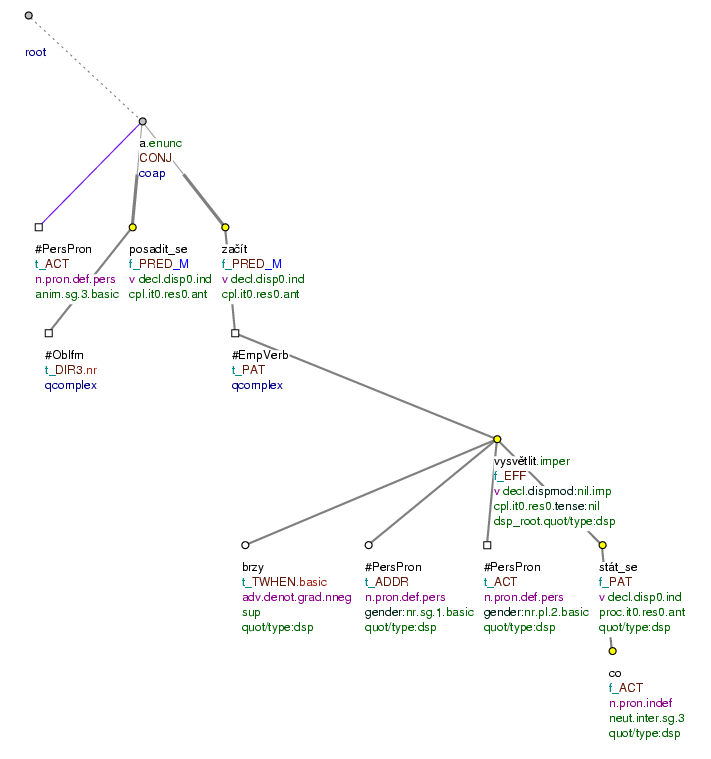
Posadil se a začal: "Nejdříve mi vysvětlete, co se stalo." (=lit. (He) sat_down REFL and began: "First_of_all to_me explain what REFL happened.")
By a noun reporting direct speech is meant a noun derived from a verb of saying, writing, noting, thinking and those non-derived nouns which typically introduce declarations and inscriptions.
For example: otázka (=question), názor (=opinion), reakce (=reaction), tvrzení (=claim), zmínka (=mention), vyznání (=confession), výrok (=statement/declaration), odpověď (=reply), zvolání (=exclamation), slovo (=word), slůvko (=just a word), formule (=formula).
Direct speech may express an argument of these nouns, or, if the reporting noun has no valency, it is represented as a non-valency modification with the functor RSTR. Thus the effective root node of the direct speech dependent on the node for the noun has the functor of one of the arguments or the functor RSTR.
Direct speech is also represented as a modification of these reporting nouns in cases where the direct speech and the reporting noun are not in contact at surface level. This rule does not only apply to direct speech in constructions with a verbonominal predicate. Cf.:
-
"Co kdyby nám někdo přispěl.
PAT?" klade řečnickou otázku trenér. (="What if someone were to make a contribution?" asks the coach rhetorically.)Direct speech is represented as the Patient of the noun otázka (=question).
-
Jeho slova byla překvapivá: "Závidím mu." (=His words were surprising: "I envy him.")
Direct speech in a construction with a verbonominal predicate (in which the direct speech is detached from its potential reporting noun) is not represented as a modification of the noun slovo (=word). For rules for annotation of these constructions see Section 3.2, "Direct speech is not a modification of the reporting clause".
NB! The above-mentioned nouns can also introduce meta-usage of an expression or an entire construction; on this, see Section 3.3, "Borderline cases between direct speech and meta-usage".
NB! The following nouns are not treated as nouns introducing direct speech: nápis (=notice/inscription), text (=text), výraz (=expression). Quotations following them are treated as meta-usage (see also Section 3.3, "Borderline cases between direct speech and meta-usage").
Direct speech as the argument of a noun in a reporting clause. If direct speech expresses the argument of a noun in a reporting clause and unless the given valency position is already filled by another modification, the effective root node of the direct speech has the functor of one of the arguments and is dependent on the node for the noun. Cf.:
-
Rozkaz zněl stroze: " Odejděte.
PAT!" (=The command sounded severe: "Go away!")Direct speech is represented as the Patient of the noun rozkaz (=command).
-
Rozkaz k odchodu zněl stroze: "Odejděte!" (=The command to leave sounded severe: "Go away!)
Direct speech cannot be represented as the Patient of the noun rozkaz (=command), because the given valency position is already occupied by the prepositional phrase k odchodu (=to departure). The construction will be represented as involving a paratactic relationship of the direct speech and the reporting clause (see Section 3.2, "Direct speech is not a modification of the reporting clause").
Examples:
Jeho odpověď "Přijdu.PAT " nás překvapila. (=His reply "I'll come" surprised us.) Fig. 8.46
Nesdílím názor trenéra: "Hráč pro zranění nenastoupí.PAT ." (=I do not share the coach's opinion: "A player won't turn up after an injury.")
O České republice padla v článku jediná zmínka: "Stavbu je.EFF třeba podpořit." (=There was only one mention of the Czech Republic in the article: "The construction must be supported.")
Direct speech as a modification with the functor RSTR. If the direct speech expresses modification of a noun, but the noun has no valency (requires no obligatory modification), the effective root node of the direct speech has the functor RSTR and is dependent on the node for the noun. Cf.:
-
Jeho slova "Závidím.
RSTRmu." nás překvapila. (=His words "I envy him" surprised us.)Direct speech is represented as a modification with the functor
RSTRdependent on the noun slovo (=word) (cf. Fig. 8.47).
Further example:
Prý se zabarikádovali za formulí "Žádné zvýšení.RSTR platů bez snížení nákladů" a nepředkládají žádné konkrétní návrhy. (=Apparently, they have barricaded themselves behind the slogan "No pay increase without a reduction of costs" and offer no concrete proposals.)
